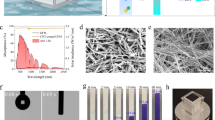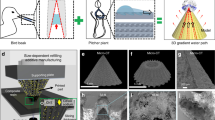Abstract
Although solar-driven reverse distillation integrated with thermal localization has recently shown attractive solar-to-water conversion efficiency, effective salt rejection/discharge approaches are scarce for achieving sustainable passive solar desalination. Here we elaborately fabricated solar distillation devices based on reverse-evaporating water layers of millimetre-scale thickness and successfully realized simultaneous high efficiency and salt rejection during solar desalination processes. Two passive operation modes (gravity mode and discharge mode) were developed for sustainable salt rejection, which showed solar-to-water conversion efficiencies of 59.1% and 60.6%, respectively, with 3.5 wt% brine. More notably, the device fabricated also showed excellent capacity (47.4% efficiency) to continuously desalt high-salinity (21 wt%) water without salt crystallization. For a wide application level, we discussed and tested ten-stage desalination devices based on reverse-evaporating water layers. A total efficiency of 354% was achieved alongside the success of salt rejection in each stage, indicating a new pathway for passive solar high-efficiency and salt-rejection desalination.
This is a preview of subscription content, access via your institution
Access options
Subscribe to this journal
Receive 12 digital issues and online access to articles
$99.00 per year
only $8.25 per issue
Buy this article
- Purchase on Springer Link
- Instant access to full article PDF
Prices may be subject to local taxes which are calculated during checkout






Similar content being viewed by others
Data availability
The data supporting the findings of this study are available within the paper and its Supplementary Information.
Code availability
The code used in this study is available from the corresponding authors upon reasonable request.
References
Ghasemi, H. et al. Solar steam generation by heat localization. Nat. Commun. 5, 4449 (2014).
Ni, G. et al. Steam generation under one sun enabled by a floating structure with thermal concentration. Nat. Energy 1, 16126 (2016).
Tao, P. et al. Solar-driven interfacial evaporation. Nat. Energy 3, 1031–1041 (2018).
Yang, Y. et al. A diode-like scalable asymmetric solar evaporator with ultra-high salt resistance. Adv. Funct. Mater. 33, 2210972 (2023).
Chiavazzo, E. et al. Passive solar high-yield seawater desalination by modular and low-cost distillation. Nat. Sustain. 1, 763–772 (2018).
Xue, G. et al. Highly efficient water harvesting with optimized solar thermal membrane distillation device. Glob. Chall. 2, 1800001 (2018).
Zhang, L. et al. Passive, high-efficiency thermally-localized solar desalination. Energy Environ. Sci. 14, 1771–1793 (2021).
Wang, F. et al. A high-performing single-stage invert-structured solar water purifier through enhanced absorption and condensation. Joule 5, 1602–1612 (2021).
Xu, Z. et al. Ultrahigh-efficiency desalination via a thermally-localized multistage solar still. Energy Environ. Sci. 13, 830–839 (2020).
Wang, W. et al. Simultaneous production of fresh water and electricity via multistage solar photovoltaic membrane distillation. Nat. Commun. 10, 3012 (2019).
Wang, W. et al. Integrated solar-driven PV cooling and seawater desalination with zero liquid discharge. Joule 5, 1873–1887 (2021).
Ni, G. et al. A salt-rejecting floating solar still for low-cost desalination. Energy Environ. Sci. 11, 1510–1519 (2018).
Zhang, Y., Xiong, T., Nandakumar, D. K. & Tan, S. C. Structure architecting for salt-rejecting solar interfacial desalination to achieve high-performance evaporation with in situ energy generation. Adv. Sci. 7, 1903478 (2020).
Liu, H., Huang, Z., Liu, K., Hu, X. & Zhou, J. Interfacial solar-to-heat conversion for desalination. Adv. Energy Mater. 9, 1900310 (2019).
Zhao, F. et al. Materials for solar-powered water evaporation. Nat. Rev. Mater 5, 388–401 (2020).
Sheng, M. H., Yang, Y. W. & Bin, X. Q. Recent advanced self-propelling salt-blocking technologies for passive solar-driven interfacial evaporation desalination systems. Nano Energy 89, 106468 (2021).
Xu, K. Y., Wang, C. B. & Li, Z. T. Salt mitigation strategies of solar-driven interfacial desalination. Adv. Funct. Mater. 31, 2007855 (2021).
Xu, W. et al. Flexible and salt resistant Janus absorbers by electrospinning for stable and efficient solar desalination. Adv. Energy Mater. 8, 1702884 (2018).
Li, L. X. & Zhang, J. P. Highly salt-resistant and all-weather solar-driven interfacial evaporators with photothermal and electrothermal effects based on Janus graphene@silicone sponges. Nano Energy 81, 105682 (2021).
Chen, X., He, S. M. & Falinski, M. M. Sustainable off-grid desalination of hypersaline waters using Janus wood evaporators. Energy Environ. Sci. 14, 5347–5357 (2021).
Xia, Y. et al. Spatially isolating salt crystallisation from water evaporation for continuous solar steam generation and salt harvesting. Energy Environ. Sci. 12, 1840 (2019).
Wu, L. et al. Highly efficient three-dimensional solar evaporator for high salinity desalination by localized crystallization. Nat. Commun. 11, 521 (2020).
Kuang, Y. D., Chen, C. J. & He, S. M. A high-performance self-regenerating solar evaporator for continuous water desalination. Adv. Mater. 31, 1900498 (2019).
Zhang, L. et al. Highly efficient and salt rejecting solar evaporation via a wick-free confined water layer. Nat. Commun. 13, 849 (2022).
Zhang, Y. et al. Guaranteeing complete salt rejection by channeling saline water through fluidic photothermal structure toward synergistic zero energy clean water production and in situ energy generation. ACS Energy Lett. 5, 3397–3404 (2020).
Zhang, Y. X., Zhang, H. & Xiong, T. Manipulating unidirectional fluid transportation to drive sustainable solar water extraction and brine-drenching induced energy generation. Energy Environ. Sci. 13, 4891 (2020).
Yang, K. et al. Three-dimensional open architecture enabling salt-rejection solar evaporators with boosted water production efficiency. Nat. Commun. 13, 6653 (2022).
Morciano, M. et al. Solar passive distiller with high productivity and Marangoni effect-driven salt rejection. Energy Environ. Sci. 13, 3646 (2020).
Liu, G. H. et al. Salt-rejecting solar interfacial evaporation. Cell Rep. Phy. Sci. 2, 100310 (2021).
Li, X., Xie, W. & Zhu, J. Interfacial solar steam/vapor generation for heating and cooling. Adv. Sci. 9, 2104181 (2022).
Zhang, Y. & Tan, S. C. Best practices for solar water production technologies. Nat. Sustain. 5, 554–556 (2022).
Acknowledgements
This work was jointly supported by the National Natural Science Foundation of China (no. 51976013 and no. 52006124) and the Beijing Natural Science Foundation (no. 3232031). We thank G. Wu, S. Liang, Y. Ji, D. Shi and Q. Ma for their help in measuring the optical parameters of the convection cover and the TiNOx-coated aluminium plate, and P. Ren for his help in taking optical photos of hydrophobic membranes. Z.Z. thanks S. Liang, H. Cheng and R. Jin for their help with the experiments.
Author information
Authors and Affiliations
Contributions
H.Z. and Z.Z. conceived the idea. H.Z. and J.X. guided the research. Z.Z. and X.M. carried out the experiments. Z.Z. and H.K. performed the numerical simulation. Z.Z., J.X., X.M. and H.Z. discussed the results. Z.Z. wrote the first version of the paper. J.X., H.K. and Z.Z. revised the paper.
Corresponding authors
Ethics declarations
Competing interests
The authors declare no competing interests.
Peer review
Peer review information
Nature Water thanks Chengbing Wang and the other, anonymous, reviewer(s) for their contribution to the peer review of this work.
Additional information
Publisher’s note Springer Nature remains neutral with regard to jurisdictional claims in published maps and institutional affiliations.
Supplementary information
Supplementary Information
Supplementary Notes 1–16, Figs. 1–25 and Tables 1–5.
Source data
Source Data Fig. 2
Source Data Fig. 2.
Source Data Fig. 4
Source Data Fig. 4.
Source Data Fig. 5
Source Data Fig. 5.
Source Data Fig. 6
Source Data Fig. 6.
Rights and permissions
Springer Nature or its licensor (e.g. a society or other partner) holds exclusive rights to this article under a publishing agreement with the author(s) or other rightsholder(s); author self-archiving of the accepted manuscript version of this article is solely governed by the terms of such publishing agreement and applicable law.
About this article
Cite this article
Zhu, Z., Zheng, H., Kong, H. et al. Passive solar desalination towards high efficiency and salt rejection via a reverse-evaporating water layer of millimetre-scale thickness. Nat Water 1, 790–799 (2023). https://doi.org/10.1038/s44221-023-00125-1
Received:
Accepted:
Published:
Issue Date:
DOI: https://doi.org/10.1038/s44221-023-00125-1



